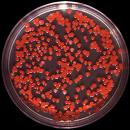Serratia has dark history in region
Army test in 1950 may have changed microbial ecology
Serratia is a bacterium that some doctors and residents of the Bay Area have been familiar with for many years.
In 1950, government officials believed that serratia did not cause disease. That belief was later used as a justification for a secret post-World War II Army experiment that became a notorious disaster tale about the microbe.
 The Army used serratia to test whether enemy agents could launch a biological warfare attack on a port city such as San Francisco from a location miles offshore.
The Army used serratia to test whether enemy agents could launch a biological warfare attack on a port city such as San Francisco from a location miles offshore.
For six days in late September 1950, a small military vessel near San Francisco sprayed a huge cloud of serratia particles into the air while the weather favored dispersal.
Then the Army went looking to find out where it landed. Serratia is known for forming bright red colonies when a soil or water sample is streaked on a culture medium — a property that made it ideal for the bio-warfare experiment.
Army tests showed that the bacterial cloud had exposed hundreds of thousands of people in a broad swath of Bay Area communities including Sausalito, Albany, Berkeley, Oakland, San Leandro, San Francisco, Daly City and Colma, according to reports that later were declassified. Soon after the spraying, 11 people came down with hard-to-treat infections at the old Stanford University Hospital in San Francisco. By November, one man had died. Edward Nevin, 75, a retired Pacific Gas and Electric Co. worker recovering from a prostate operation, had succumbed to an infection with Serratia marcescens that attacked his heart valves.
More… ➡
– Research thanks to California Refugees In New Zealand